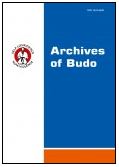2021, Volume 17
Evaluation of judo practitioners’ motor performance in relation to the criterion of targeted fitness of pilot cadets after a six-month training process
Zbigniew Wochyński1
1Department of Air Transport Safety, Polish Air Force Academy, Dęblin, Poland
Author for correspondence: Zbigniew Wochyński; Department of Air Transport Safety, Polish Air Force Academy, Dęblin, Poland; email: zbigniew.wochynski@op.pl
Full text
Abstract
Background and Study Aim: The degree of physical load and the assessment of the effects of motor skills is the most important aspect of motor preparation of judo practitioners and pilots. Due to the type of physical preparation of judo practitioners and pilot cadets, the comparison of fitness between these groups can contribute to the verification of the training programme in terms of load optimization. The aim of this paper is the knowledge about an effect of a six-months training on the motor fitness of judo practitioners compared to a group of pilot cadets (control group).
Materials and Methods: The research covered male cadets, mostly aged 19 who are students at the Air Force Military Academy in Dęblin. The cadets were divided into two groups. Group A was made up of students practising judo in a sports section, whereas group B was made up of pilot cadets who follow the programme of pilot training. The students underwent fitness tests before (examination I) and after (examination II) a six-month training period: Aviation Synthetic Efficiency Test (ASET); 1,000 m run,100m run, pull-ups on the bar and a ‘Rotational Test’. All the students had their heart rate (HR), blood pressure (BPS, BPD) measured prior to and after completing the ASET.
Results: In group A in examination II, there was a statistically significant increase in the ASET performance (p<0.0001), 1,000 m run, (p<0.0001) and the ‘Rotational Test’ (p<0.0001) in relation to examination I. In group B, in examination II, there was a statistically significant increase in the ASET performance (p<0.01), in the 1,000m run (p<0.01) and pull-ups on the bar (p<0.02) in examination II in relation to examination I. In group B, the HR, BPS, BPD findings were significantly higher before and after completing the ASET than in group A.
Conclusions: A six-month training period for the judo practitioners significantly improved the performance in the ASET, in the 1,000m run and in the ‘Rotational Test’. Thus, judo is an important element in supporting the fitness of future military pilots, however, judo training is a more useful method of physical and mental preparation for survival.
Key words: survival, ‘Rotational Test’, non-apparatus test, Aviation Synthetic Efficiency Test




